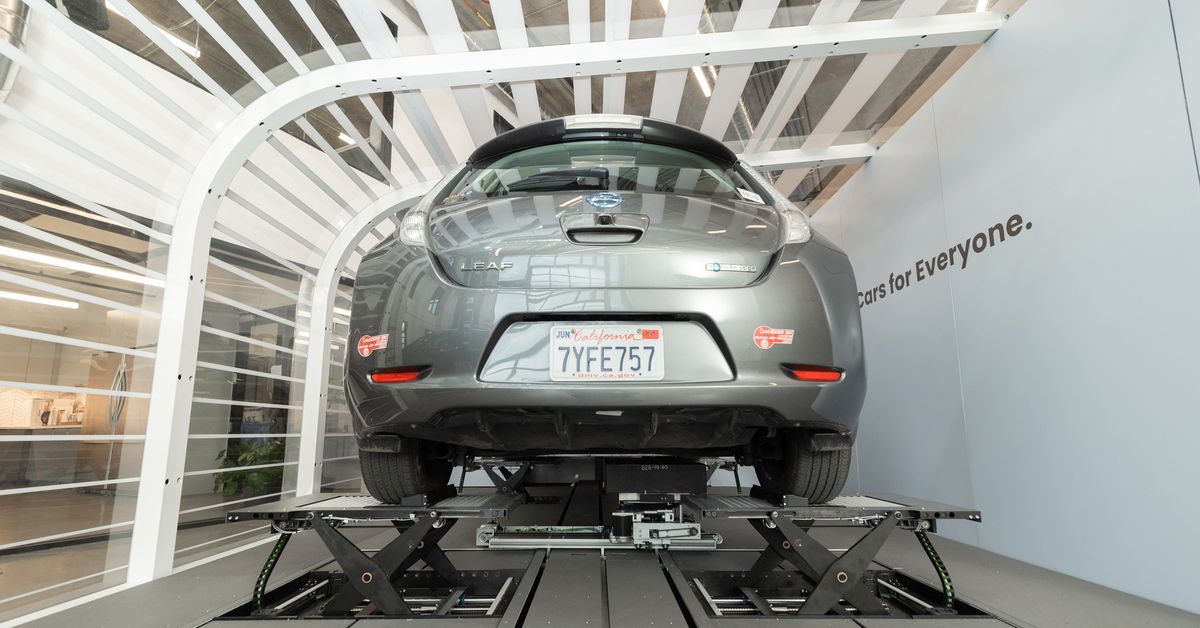Let’s say the infrastructure is there for this, and you don’t have to purchase the battery with a new EV…you just purchase a battery plan for like 100$ a month. It’d easily cut 10-20k off the cost of an EV up front.
Plus, quick charging isn’t quick. At best you’re looking at a 20 minute stop, and you’re praying a stall is open when you get there. This could solve that problem as well.
It’s an interesting idea.
Especially living in a city, this looks interesting to me. ‘Fast’ charging I’ve seen was in the range 30-60 min but then it’s like the phone, from about 20% up to 80%. So living in a city, I’d have to wait for half an hour for half the battery.
With a swap-station, it could be nearly as fast as a fossil fuel stop. About 2 minutes for a 0% to 100% stop.
This also allows for smaller batteries, for smaller cars, for lighter cars. You don’t need to carry a lot of overall range if you can swap/refill to 100% in 2 minutes.
I see comments like this about EVs all the time but it just isn’t my experience at all. I’ve never in my life charged for an hour at a DC fast charger. On most EVs, you’ll see a 15-30 minutes for 0-80% charge but you don’t have to charge above 60% where the charge rate usually slows significantly. For instance, a 10-60% charge on my car takes about 10 minutes and that gets me close to 150 miles of range. All of this assumes you don’t have access to level 2 or even level 1 charging. If you do, then you’d never need to go out of your way to charge.
For most of the current owners it’s not a problem, EVs are expensive so they likely own houses (where they can top up whenever) and are fairly wealthy. Battery swapping means hassle free and cheap now for the rest of us.
I was going to say this is not going to work but thinking about it… it might. Swapping stations will be very hard to build and maintain but it’s not exclusive technology, i.e. cars with swappeable batters will still be chargeable. So swapping stations will be like ultra fast chargers. You will have big network or normal chargers, smaller network of fast chargers and tiny network of swapping stations in key locations. If this standard will not make the car more expensive it could be an incentive enough for people to buy them. As more cars can swap batteries they will build more swapping stations. It will not become the main way to of charging any time soon, maybe never, but it could work for longer trips.
So countries are pouring investment into charging networks… it would be interesting to know the thinking behind that versus this approach. One thing is certain though: this can only work at scale if manufacturers agree on standards for battery modules so that they can be swapped out by the same machinery. Notice that this is only for one specific model - the machine which removes the battery knows where the battery modules are and how to remove them. There would also presumably be some tradeoff for battery form factors which are designed to cram more in at the cost of making them harder to remove.
Stellantis on it’s own is pretty big, they own Fiat, PSA (Peugeot & Citroen), Opel, Chrysler, Dodge, Jeep off top of my head. Some smaller brands too. They might be starting with Fiat 500e since 500 line is a budget one that could have price driven even lower by decoupling battery cost.
This is a different idea than I read from the article.
I read “swappable”, as a substitute for charging, and believe that has been proven impractical by every company that has tried it so far.
“Replaceable” batteries to support battery leasing and enable cheaper chemistry even if it doesn’t last as long, is an entirely different story. You’re not expecting frequent or fast changeout, you don’t need vast infrastructure or to stock every variation, you don’t need every brand to reach consensus , you just need to sell your dealer one or two machines and they only need to stock for what they sell. It gives dealers a reason to continue existing (which I don’t agree with but can understand)
Been wanting this for a while. Make a battery standard. You stop and swap out a charged battery for your used battery via a system like a drive through car wash. Pull into the bay and the machinery automatically does the work.
It may not be such a huge deal for cars that do mostly local driving, but I think it would be great for longer haul trucks to move into the EV world if the major highways had such stations along the route.
Excellent, making it was easy to swap w battery is the way to go. I was getting hate in the ev community stating that making batteries replaceable and swappable was not a real problem.
This has been on the way in Europe for a decade now. Just wasn’t quite mature.
Im jealous.
Just my personal opinion, Swapping sounds nice until you think about it. There’s a reason battery swaps haven’t been successful, and that is that for it to work, we need universally used battery types, that can be swapped by the same equipment. When batteries are not standardized, a swapping station can only serve very few models or would need huge stock of different types of swappable batteries. Both situations means great distance between swap stations, compared to universal charging stations. Apart from that there are other problems, like batteries will be unlikely to be owned, but need to be leased, usually adding extra cost.
Tesla worked with battery swaps too, but discarded the idea pretty quickly, and Tesla has been right more often than not on this kind of issue. AFAIK BYD is working on it too, but my guess is even they will fail, despite being #1 China EV/Battery manufacturer.
I’d love to be wrong though.I think you’re right, it really may be an insurmountable logistics issue. But it’s also a complete nonstarter in a world where the only difference between models (or often their prime upselling point) is the battery capacity. There could theoretically be some kind of EU-style mandate for standardized battery sizes but I sincerely doubt it’ll happen until well past the time the market is concerned about and motivated by range.
This is the best summary I could come up with:
Stellantis struck a deal with California-based EV battery swapping company Ample to power a fleet of shared Fiat 500e vehicles in Spain.
By becoming one of the first Western automakers to embrace battery swapping technology, Stellantis is betting that EV charging infrastructure in Europe and the US will remain a barrier to adoption in the near future, necessitating other solutions.
Stellantis will work with Ample to launch a battery swapping system for a fleet of Fiat 500e vehicles as part of a car-sharing service through its Free2move subsidiary.
“Our system knows how many batteries are in the Fiat 500e, knows how to extract each one of those modules, and put them back in the same arrangement,” Khaled Hassounah, CEO of Ample, said in a briefing with reporters.
If the company does decide to expand its partnership with Ample, the Fiat 500e will likely be the first vehicle to support the technology, said Ricardo Stamatti, senior VP for charging and energy at Stellantis.
Customers who buy cars that are compatible with Ample’s swapping system would then just subscribe to a battery, opening up a possible new line of revenue for Stellantis.
The original article contains 648 words, the summary contains 190 words. Saved 71%. I’m a bot and I’m open source!
I don’t see how battery swapping is a good bet. We’ve already got extremely fast charging, and the maintenance and capital investment for swapping stations would be enormous.
It has some benefits to both consumers and automotive industry.
I live in an apartament block, as do many people. Can’t really charge when parking by the street. If I could go into subscription like service with a charging network where I don’t own the battery outright and just swap it at gas stations that solves a lot of issues. It’s faster than charging and I don’t have to own a battery outright which lowers initial investment. That battery doesn’t even have to have that great of a range either. Car company / charging network or whoever does the battery leasing benefits long term because they can charge more overall.
I’ve been saying this for years. It just seems to make so much sense.
Hope it works out.
Why can’t you charge on the street? You could have parking meter type slow chargers.
I’ve had an EV for three years now without my own charging station. It’s sometimes inconvenient but not a big issue.
There was a guy who lived near me who plugged his Tesla in on the street. Unfortunately for him, the charging port is on the driver side which meant it dangled out into the road.
One day I drove by and his charger had gotten knocked off by another car. I bet that was a pretty penny to fix.
Those need to get electricity from somewhere and in many countries overall infrastructure is woefully unprepared for large scale deployment of this type, not to mention being unprepared for how renewable energy is produced and stored. It’s also quite vulnerable to vandalism.
This is literally a huge pile of batteries that can charge at any rate at any time. It can soak the noon peak of solar, it can sip late night wind.
I’m looking forward to someone creating a Mobil charging service, a megacharger on a Cybertruck, that just rolls around city streets topping off its customers
I thought this was such a cool idea when I first read about it … in 2014. Quite a few manufacturers have done trials and decided it wasn’t practical, so I don’t see how this is any different.
Now we’re at the point where batteries last longer than most people own vehicles, supercharger networks are widespread and expanding rapidly, charging is faster than ever, and we have Toyota’s fud promising 10 minute charging. We also have improved construction methods with batteries incorporated into the structure of vehicles rather than bolted on, on one end.
Swappable batteries fly in the face of this: we’d have to give up too much, and it assumes cooperation from all manufacturers and a huge infrastructure buildout that will just never happen. We’re well past the point of this looking like a good idea.
Let me throw this in the bin with the hydrogen fans, although there’s a place for that where batteries won’t scale. People keep complaining it is so difficult, time consuming, costly, to build out a better power grid for renewables and BEV, when it’s just adding flexibility and capacity to a system that’s already there and well understood. Yet you yahoos think it will somehow be faster and cheaper to invent an entirely new infrastructure, create agreement among many manufacturers worldwide, create new industries, and scale it out worldwide? What the everliving fuck?
I’m all for trying new things, however there’s tradeoffs with this approach I think that people may not be grasping that may change their mind if they want this.
-
the conversion to the vehicle will mean less space for battery because the housing, latches, connectors, etc have to be added to support an easily removable battery. So a 200 mile range battery may mean dropping to 150 mile range or less just to have the option to swap batteries.
-
Good EVs batteries use liquid thermal management, including the Fiat 500e noted in this article. It looks like this company is removing the liquid battery and replacing it with their own battery module. From the end of the article.
Updated December 7th 11:55AM ET: Ample’s modular batteries are compatible with any EV, the company says. A previous version of this story misstated this.Without liquid thermal management the car is much more negatively affected by cold and hot days limiting range (and life of the battery which will increase costs of subscription).
-





